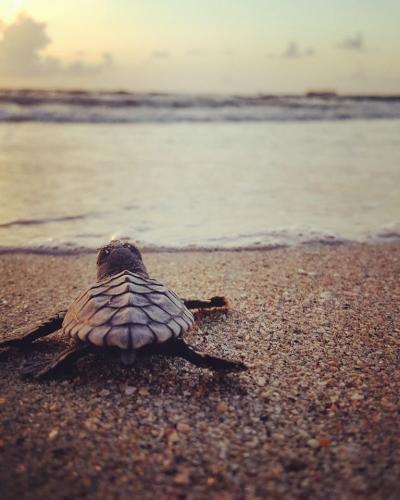sea turtles
Learn about sea turtle nesting season, where they are born and how you can help...
Your browser is not supported for this experience.
We recommend using Chrome, Firefox, Edge, or Safari.
Florida has a rich environment, making it home for a unique array of animals from alligators and manatees to iguanas and majestic herons. But something that makes Greater Fort Lauderdale special is the roughly 2,000 sea turtle nests that are built on the beaches each summer. Our community does its best to protect these creatures throughout conservation projects, while still allowing the public to witness nesting and releases. After all, Greater Fort Lauderdale is for everyone under the sun, including sea turtles!

Sea turtle season runs from March 1 to October 31 every year. During the season, female sea turtles crawl onto the beaches at night, lay their eggs in the safety of a nest they build, and then head back into the ocean. It takes about two months for the eggs to hatch, and the millennia of biology that is ingrained into the hatchlings leads them back into the ocean by the light of the moon. When they lay eggs of their own one day, they head back to the beach where they were born, and the cycle continues.
While there are five species of sea turtle that call the Sunshine State home, only three find their way onto the shores of Greater Fort Lauderdale: the leatherback, loggerhead, and green turtle. Loggerheads make up about 90% of nests in Florida; even so, they’re considered a threatened species and are protected under the Federal Endangered Species Act.
Broward County’s Natural Resources Division runs the sea turtle conservation program, keeping close track of every sea turtle that makes its way onto the beaches and lays a nest. That’s 26 miles of coastline, except for the beach at Dr. Von D. Mizell-Eula Johnson State Park, since it’s not county property.
Unfortunately, only about one in every 1,000 hatchlings will make it to the ocean. They can perish from dehydration if they don’t make it to the water quickly enough, or they are snatched up by predators on the beach, including birds and crabs. To try and help sea turtles, the county’s observation program erects wooden stakes around every nest so beachgoers know to keep away, and when the eggs hatch, they are retrieved to later be released.
As you drive up and down A1A during sea turtle season, you’ll notice that the street lights and even the bulbs used in condos and hotels are a darker amber color. That’s because these turtle-friendly lights are less visible to the creatures, meaning hatchlings won’t accidentally confuse the lights for the moon and head in the wrong direction

There are safe ways for visitors in Greater Fort Lauderdale to witness sea turtle nesting season. Check out the following sustainable tourism activities around town:
(Photo courtesy of Jennifer Andrighetti Photography)
MORE INFORMATION:
Learn about sea turtle nesting season, where they are born and how you can help...
